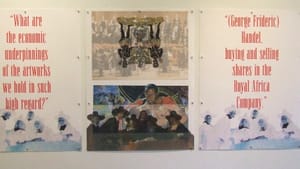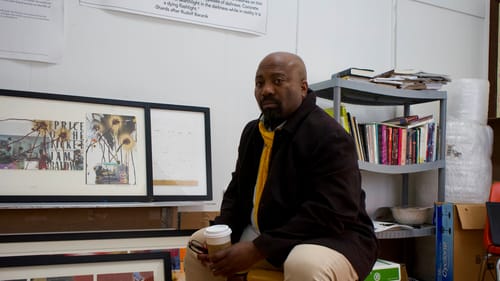Stay in the Loop
BSR publishes on a weekly schedule, with an email newsletter every Wednesday and Thursday morning. There’s no paywall, and subscribing is always free.
Lines of inquiry
The Center for Emerging Visual Artists presents Thesentür/The Thinker: Nina Simone and the Politics of Music

It’s bracing to emerge from the elevator in the posh, historic Barclay building on Rittenhouse Square and see a print asking, “Who teaches you to make art under a dictatorship?” That’s how Philadelphia conceptual artist and writer Theodore A. Harris greets us in his new solo show, Thesentür/The Thinker: Nina Simone and the Politics of Music.
Harris works in collage, mixing layers of ideas and symbols that bluntly confront injustice. In this exhibition at the Center for Emerging Visual Artists (CFEVA), he offers 13 text-based prints and found objects about the underlying connections among the arts, patronage, the slave trade, and racism.
A curatorial starting point
Many of the artworks raise questions that can lead a curious viewer down endless avenues of research later. Thesentür (up through December 20, 2024) is not focused solely on Simone but rather uses her experience with the Curtis Institute of Music as a foundation and a curatorial starting point for related works.
After her 1951 audition, Simone believed she was not accepted at the Curtis Institute because she was Black. Curtis, which celebrated its centennial this year, denies this, pointing out that students qualify by audition. (Curtis does not charge tuition, and worldwide competition for admission is fierce; the conservatory reports an acceptance rate of only four percent.)
Striking ideas meet The Syndics
This exhibition is part of Harris’s CFEVA 2022 Fellowship project, which includes programs and a book by Harris, Thesentür/The Thinker: Nina Simone and the Politics of Music, published in April, with an essay by Stan Mir. While the production quality in the book and some of the graphics is uneven, conceptual art emphasizes ideas more than the art object itself, and Harris’s ideas are striking.
The series of Thesentür prints is text-based, incorporating statements by others. By referring to “Thesentür”—literally the “theses door” in Wittenberg, Germany—Harris evokes Martin Luther’s role as a controversial reformer. In many of the works, bold red lettering seems to hang over the judgmental gentlemen of Rembrandt van Rijn’s group portrait, The Sampling Officials of the Amsterdam Drapers’ Guild, painted in 1662 (also called The Syndics).
Most of the prints are minimal, vertically oriented, with the words packing the punches. Like the Dutch Masters Cigar Company, which appropriated The Syndics for its packaging, Harris has removed the painting’s background. Only the men remain, sometimes in Rembrandt’s russet tones, sometimes in pale blue.
Mary Louise Curtis Bok, who founded Curtis, liked The Syndics so much that she had a replica painted, which is now prominently displayed at Curtis’s Rittenhouse Square building. Curtis offered to lend the reproduction to the exhibition, but the picture was too big to make it around an angle in the hallway. Instead, Harris displays an image of the reproduction, as well as the large piece of cardboard used by art handlers to test whether it could be moved to CFEVA’s space.
Art, artists, patrons, and money
In Harris’s triptych, After Nina Simone 1, half here/half gone (2022), two more quotes from Simone say: “The FBI, they went to Curtis Institute and inquired about me,” and, “They asked Vladimir Sokoloff was I mixed up in the rebellion.” (We might well ask, “Rebellion?”) It would be interesting to see the FBI file on Simone, but the agency says the papers have been destroyed.

Harris questions the ways that art, artists, patrons, and money are bound together in a piece that shifts our focus from Simone in the early 1950s to George Frideric Handel in the early 1700s. In After David Hunter ghosts 1 (2022), the first panel reads: “What are the economic underpinnings of the artworks we hold in such high regard?” The answer involves Handel’s finances and two slave-trading companies: the South Sea Company and the Royal African Company.
Harris’s revelatory work offers much to explore and think about. For instance, an installation set in the gallery’s fireplace—a collaboration with Philadelphia artist Taji Ra’oof Nahl—retains a sense of mystery. Its elements are a Bembe People’s mask, a soup tureen, a stalk of cotton bolls, and a few books, all tidily stacked in the grate. Somehow, it is both mournful and menacing, poignantly vulnerable and angry as hell.
Related programs at CFEVA include Hearing Justice: A Sonic Response in Solidarity with a Colonial Critique, with Walter Gershon and Nahl in performance on Friday, December 6, and a conversation with Mir on Thursday, December 12. They’re free to attend with RSVP required.
Disclosure: Writer Emily Schilling and Theodore A. Harris were presenters at a symposium organized by the Philadelphia Avant-Garde Studies Consortium in 2019, and both worked on its print publication and image research unrelated to this exhibition in 2020.
What, When, Where
Thesentür/The Thinker: Nina Simone and the Politics of Music. Through December 20, 2024, at the Center for Emerging Visual Artists, 237 S 18th Street, Suite 3A, Philadelphia. (215) 546-7775 or cfeva.org.
Accessibility
This exhibition is accessible by elevator. For more information, call (215) 546-7775.
The gallery will be closed on November 28-30, 2024.
Sign up for our newsletter
All of the week's new articles, all in one place. Sign up for the free weekly BSR newsletters, and don't miss a conversation.
 Emily Schilling
Emily Schilling